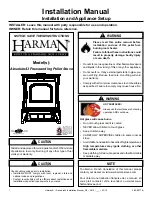
~ 5 ~
Single wall
connector pipe
Double wall
connector pipe
A – Chimney Connector to backwall
16.5” (419 mm)
10.5” (267 mm)
B – Chimney Connector to sidewall
22” (559 mm)
18” (457 mm)
C – Chimney Connector to cornerwall
20” (508 mm)
15” (381 mm)
D – Unit to backwall
14” (356 mm)
8” (203 mm)
E – Unit to sidewall
14” (356 mm)
10” (254 mm)
F – Unit to cornerwall
11.5” (292 mm)
6.5” (165 mm)
For connecting into existing Chimney:
The Chimney should be swept prior to installation and smoke tested to ensure it is sound.
The Chimney must not have any hollow sections present, these should be filled to ensure
that any soot or tar, etc. does not build up which may present problems when sweeping
the chimney. Hollow sections within the chimney may also present problems with the
chimney draw. The connecting flue pipe must be sealed to the chimney with fire cement
and high temperature resistant rope as required. This is usually done into a register
(Blanking) plate with an access door/hatch to enable chimney sweeping. Particularly
large chimneys may require lining as the flue temperature may not get warm enough to
provide a suitable up-draught.
Minimum diameter should be no less than the outlet size of the stove, 25to 50mm larger
is ideal. Where the stove outlet is less than 150mm this diameter should be no less than
125mm when only burning smokeless fuels or a minimum of 150mm for any fuel types.
Horizontal
flue.
Soot/Access
Door
Fill
Void
Fire
retardant
Rope
seal
required
Allow
area
for
collecting
soot
build
up.
Minimum
distance
should
be
no
less
than
The
outlet
diameter
of
the
stove.
Build
up
opening
Parallel Installation
Corner Installation



































